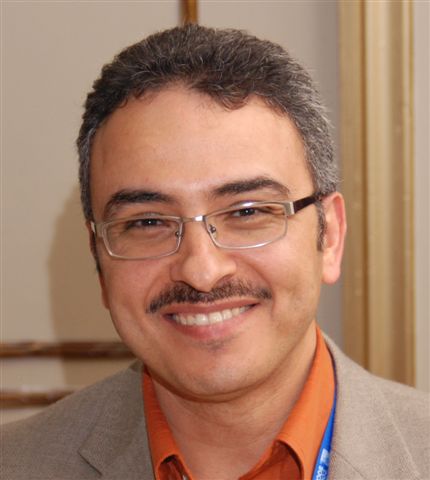12-th ACM MSWiM 2009
Keynote Speakers
In addition to scientific papers, the MSWiM 2009 program includes 3 distinguished Keynote Speakers.
Keynote abstract: Recently, the development in the area of decentralized systems and infrastructureless networks opened avenues for novel applications. A prominent example is the support of on-site units in large scale emergency response scenarios. Here, a combination of peer-to-peer systems and mobile ad hoc networks forms a communication substrate for offering enhanced services beyond the borderlines of the 'traditional' infrastructure-based client/server world. More representatives of the decentralized/infrastructureless domain such as service oriented architectures and mesh and sensor networks also already left their starting blocks.
Along with these new technologies new questions regarding their operational bounds in terms of scalability, security, and QoS arose, to name just a few. Due to the yet sparse presence of real-world decentralized and infrastructureless systems, new protocols and applications have to be scrutinized by means of simulation and in (small-scale) testbeds. In addition, mathematical models must be developed both to verify the validity of results obtained from simulation and testbed studies and to provide tools for the online adaptation of relevant system parameters in future real-world scenarios.
In this talk we highlight upcoming trends in decentralized systems and infrastructureless networks. We present recently finished and ongoing work of German research projects such as SicAri, SoKNOS, and G-Lab that focus (amongst other objectives) on the emergency response application scenario. In this context, we identify open issues still demanding for appropriate models in order to support studies in testbeds and simulation environments and to help paving the way for real-world deployment of the developed prototypes.
Short Bio: Since early 1996, Dr. Ralf Steinmetz has been a professor at the dept. of Electrical Engineering and Information Technology as well as at the dept. Computer Science of the Darmstadt University of Technology, Germany. There he is in charge of a chair position as managing director of the "Multimedia Communications Lab". From late 1996 until late 2001 he directed the Fraunhofer (former GMD) Integrated Publications and Information Institute IPSI. In 1999 he founded the Hessian Telemedia Technology Competence Center (httc e.V.). On whose board he has since served as chair. From 2002 to 2004 as dean he managed the department.
His research interests cover networked multimedia issues with the vision of "seamless multimedia communications"; i.e. network dependability and security (e.g. gateways, firewalls), quality of service (e.g. network engineering), content distribution networks (e.g. streaming), context aware communications (e.g. peer-to-peer mechanisms), media semantics (e.g. ontology enrichment, metadata). At Darmstadt he relates these research issues often very closely to mobility, Internet telephony and telemedia learning.
He has been the editor and co-author of a multimedia course, which reflects the major issues of the first (updated in several versions) in-depth technical book on multimedia technology. He has worked as an editor of various IEEE, ACM and other journals. He has served as chair, vice-chair and member of numerous program and steering committees of communications and multimedia workshops and conferences. He is a member of the GI and VDE-ITG. He was awarded as ICCC Governor, the honour of Fellow of both, the IEEE and the ACM. In 2005 he became member of the technology advisory board of the "Hessen Agentur" and he was appointed as the advisor for information und communications technology by the Hessian government. Professor Dr. Ralf Steinmetz is a member of the Scientific Council and president of the Board of Trustees of the international research institute IMDEA Networks.
Keynote abstract: the success of emerging Broadband Wireless Access Networks (BWANs) such as 4G wireless cellular networks championed by Long Term Evolution (LTE) and IEEE 802.16 broadband wireless networks (WiMAX) will depend, among other factors, on their ability to manage their shared wireless resources in the most efficient way. This is a complex task due to the heterogeneous nature of access networks and the diverse bandwidth and Quality of Service (QoS) requirements of the applications that these networks are required support.
Resource Management (RM) in BWANs requires considerations of elements at different networking dimensions and time scales. This talk describes our efforts in addressing the challenges to RM in BWANs in three main directions. The first describes a comprehensive bandwidth provisioning framework for BWANs at different time scales. We address the problem of dynamic bandwidth allocation in BWANs. We then discuss packet scheduling schemes at the frame level that employ practical economic models through the use of novel utility and opportunity cost functions to simultaneously satisfy the diverse QoS requirements of mobile users and maximize the revenues of network operators. The second direction entails the introduction of novel and non-traditional RM mechanisms that exploit network heterogeneity. We show how technologies within a BWAN can be enhanced through joint functionalities. The third direction shows how vertical handoffs, despite their challenges, can be used to the benefit of the service provider; and how the use of wireless multi-hop communication can be utilized in a structurally-hybrid environment to maintain a robust network operation.Short Bio: Dr. Prof. Hossam Hassanein is an internationally recognized researcher in the School of Computing at Queen's University in the areas of broadband, wireless and variable topology networks architecture, protocols, control and performance evaluation. Dr. Hassanein obtained his Ph.D. in Computing Science from the University of Alberta in 1990. He is the founder and director of the Telecommunication Research (TR) Lab (http://www.cs.queensu.ca/~trl) in the School of Computing at Queen's. Dr. Hassanein has more than 350 publications in reputable journals, conferences and workshops in the areas of computer networks and performance evaluation. He has delivered several invited talks and tutorials at key international venues, including Unconventional Computing 2007, IEEE ICC 2008, IEEE CCNC 2009, IEEE GCC 2009 and IEEE ISCC 2009. Dr. Hassanein has organized and served on the program committee of numerous international conferences and workshops. He also serves on the editorial board of a number of International Journals. He is a senior member of the IEEE and is currently vice-chair of the IEEE Communication Society Technical Committee on Ad hoc and Sensor Networks (TC AHSN). Dr. Hassanein is the recipient of Communications and Information Technology Ontario (CITO) Champions of Innovation Research award in 2003. In 2007, he received best paper awards at the IEEE Wireless Communications and Networks and the IEEE Global Communication Conferences (both flagship IEEE communications society conferences). Dr. Hassanein is an IEEE Communications Society Distinguished Lecturer.
Date: Thursday, October 29, 2009, 8:30-9:30 am
Keynote title: NOTICE - An Architecture for Traffic Incident Detection
Prof. Stephan Olariu
Old Dominion University, Norfolk, Virginia, USA
Keynote abstract: Road and traffic safety can be improved if the drivers have theability to see further down the road and can be informed of relevant traffic events, including collisions and slow-downs. The recently proposed VANETs (Vehicular Ad hoc Networks) are expected to enable both vehicle-to-vehicle (V2V) and vehicle-to-roadside (V2R) communications. Virtually all the papers published in the literature assume that V2V communications will rely on a strong roadside infrastructure. Unfortunately, the roadside infrastructure, is very likely to be the target of theft, vandalism and other similar activities that will jeopardize their intended functionality. Worse yet, one can easily contemplate a scenario where the roadside infrastructure may be hacked and injected with malicious code, rendering it not only useless but, downright dangerous.
However, all the VANET systems proposed thus far are afflicted with serious security and privacy problems. Indeed, the way current systems are set up, the driver of a car that participates in the traffic will not be able to preserve their privacy and may be subject to impersonation or Sybil attacks. The problem stems from the fact that V2V communication can be traced back to an individual car. Even if several pseudonyms are used, detecting the true identity of the driver and, therefore, invading their privacy appears to be unavoidable.
In a sharp departure from the common wisdom we propose to look at vehicle-to-vehicle (V2V) and vehicle-to-roadside (V2R) communications from a different perspective. Instead of relying on the roadside infrastructure that is vulnerable to attacks, we propose to embed in the asphalt covering the surface of the roads sensor belts. Each belt consists of a collection of pressure sensors, optionally equipped with piezo-electric elements. The belts can detect and interact with passing cars.
In this keynote address we discuss in detail NOTICE and show that it can be easily extended to cover many problems of interest in infotainment and peer-to-peer content delivery. One important application of NOTICE is with planned evaluations when optimal use must be made of available transportation resourceShort Bio: Professor Stephan Olariu is a tenured full professor in Computer Science at Old Dominion University, Norfolk, Virginia. He is a world-renowned technologist in the areas of parallel and distributed systems, parallel and distributed architectures and networks. He was invited and visited more than 120 universities and research institutes around the world lecturing on topics ranging from wireless networks and mobile computing, to biology-inspired algorithms and applications, to telemedicine, to wireless location systems, and vehicular networks. Professor Olariu is the Director of the Vehicular Networking Research Group at Old Dominion University. Prof. Olariu is an Associate Editor of Networks, International Journal of Foundations of Computer Science, and serves on the editorial board of Journal of Parallel and Distributed Computing and as Associate Editor of IEEE Transactions on Parallel and Distributed Systems.

